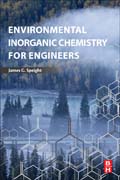
Environmental Inorganic Chemistry for Engineers explains the principles of inorganic contaminant behavior, also applying these principles to explore available remediation technologies, and providing the design, operation, and advantages or disadvantages of the various remediation technologies. Written for environmental engineers and researchers, this reference provides the tools and methods that are imperative to protect and improve the environment. The book's three-part treatment starts with a clear and rigorous exposition of metals, including topics such as preparations, structures and bonding, reactions and properties, and complex formation and sequestering. This coverage is followed by a self-contained section concerning complex formation, sequestering, and organometallics, including hydrides and carbonyls. Part Two, Non-Metals, provides an overview of chemical periodicity and the fundamentals of their structure and properties. Clearly explains the principles of inorganic contaminant behavior in order to explore available remediation technologiesProvides the design, operation, and advantages or disadvantages of the various remediation technologies Presents a clear exposition of metals, including topics such as preparations, structures, and bonding, reaction and properties, and complex formation and sequestering INDICE: Part 1: Metals 1. Preparations, Structures, and Bonding 2. Reaction and Properties 3. Complex formation and sequestering 4. Commercially important sequestering agents 5. Toxic metals and the environment 6. Chemical equilibria in liquid/liquid and liquid/solid multiphase systems 7. Influence of pH on solubility and complex formation 8. Organometallics, including hydrides and carbonyls 9. Applications to catalysis Part 2: Non-Metals 10. An overview of chemical periodicity and the fundamentals of the structure and properties (melting and boiling points, solubility, colour, stability, toxicity, etc.) of compounds of the non-metallic elements 11. Preparations, structures, reactions and properties of representative compounds and materials 12. Chemical equilibria in gas/liquid, gas/solid and gas/liquid/solid multiphase systems Part 3: Applications 13. Applications to energy supply 14. Fertilizer, pulp and paper 15. Oil and gas, ceramics, explosives 16. Polymer, detergent and the chemical industries generally and in environmental chemistry (air and water quality)
- ISBN: 978-0-12-849891-0
- Editorial: Butterworth-Heinemann
- Encuadernacion: Rústica
- Páginas: 590
- Fecha Publicación: 01/06/2017
- Nº Volúmenes: 1
- Idioma: Inglés
